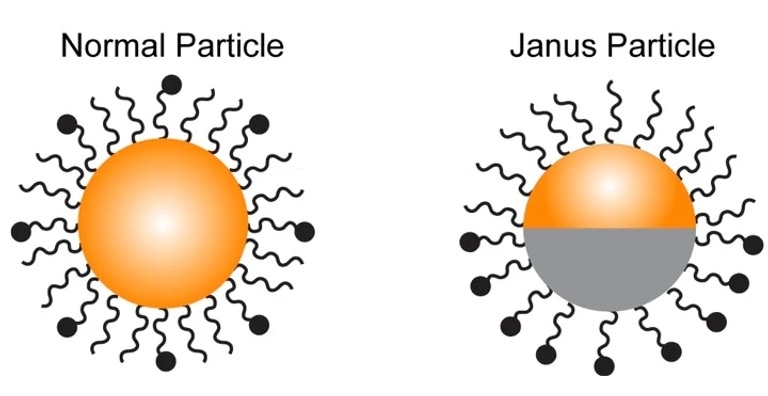Three chemists from the Indiana University Bloomington developed a novel sensor to identify chemical changes in immune cells at the time of the pathogen breakdown. The research can probably assist in the initial diagnosis and treatment of infectious diseases, like tuberculosis, that elude some elements of the body’s immune response.

Named for the two-faced Roman god, a Janus particle, right, is coated with two separate molecule types across its surface. Image Credit: Illustration by Lucy Sanchez.
The research was headed by Yan Yu, an associate professor in the IU Bloomington College of Arts and Sciences’ Department of Chemistry. The observations were published on October 8th, 2021, in the Angewandte Chemie, a leading chemistry journal.
The particles in the research were designed to comprehend phagocytosis—the mechanism through which immune cells uptake and kill pathogens in the body. The vital mechanism involves the engulfment of the pathogens into cellular compartments named phagosomes, which later “mature” through a complex sequence of chemical reactions, destroying the invading disease.
Many important cell functions, including phagocytosis, rely on the orchestration of complex chemical reactions, but measuring these different reactions in real-time inside a living cell is extremely challenging. This study shows that particles of the type designed in our lab are broadly applicable to understanding many types of complex chemical interactions in living cells.”
Yan Yu, Associate Professor, Department of Chemistry, College of Arts and Sciences, Indiana University Bloomington
The particles employed in the research are named Janus particles, named after the two-faced Roman god. They are called this as the two sides of the same particle are “coated” with various chemical sensors. These sensors are capable of acting as detectors, or “reporters,” for different chemicals involved in the biological process under examination.
Yu’s laboratory developed a technique that enables packing these receptors very close together across a Janus particle’s surface, substantially raising their efficacy as an investigative tool.
Yu’s earlier studies on Janus particles provided a new understanding of the body’s capability to defy fungal infection, and also a novel technique to activate the body’s T-cells, which are employed to combat cancer, improve immune therapy, combat viral infection, and generate tolerance in autoimmune disease.
The recent research is the subject of a patent filing with the US Patent and Trademark Office. Yu also filed a provisional patent on the newly reported discovery.
In the recent research, Yu’s group created a Janus particle whose two sides contain a 3-μm pH reporter and a 500-nm proteolysis reporter. As a result, the scientists could measure two chemical mechanisms involved in phagocytosis simultaneously—proteolysis and acidification—within a single maturing phagosome in real time.
The researchers found that phagosomes need an “acidic lumen” to activate enzymes that digest pathogens encapsulated inside, a vital step for preventing the pathogens from reproducing inside host immune cells.
The researchers also demonstrated that lipopolysaccharide, a sugar compound present in most bacteria’s outer-wall membranes, can impact proteolysis and acidification in phagosomes.
Thorough knowledge of the mechanisms is particularly vital in bacterial infections that avoid the body’s immune response by hijacking one or more events in the phagosome maturation mechanism, preventing the phagosome’s protective function. These diseases include tuberculosis, the world’s principal infectious disease killer, which kills around 1.5 million people yearly.
The Janus particles created in this study act as a sensor to detect these chemical changes inside immune cells during pathogen degradation. But, more broadly, the work showcases the feasibility of Janus particles as a general tool for monitoring multiple reactions within a cell—as well as highlights their potential for the detection and diagnosis of infectious diseases.”
Yan Yu, Associate Professor, Department of Chemistry, College of Arts and Sciences, Indiana University Bloomington
Source:
Journal reference:
Lee, S., et al. (2021) Real-time Simultaneous Imaging of Acidification and Proteolysis in Single Phagosomes Using Bifunctional Janus Particle Probes. Angewandte Chemie. doi.org/10.1002/anie.202111094.